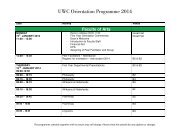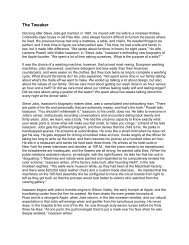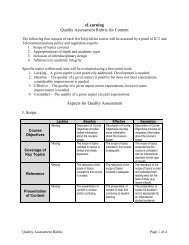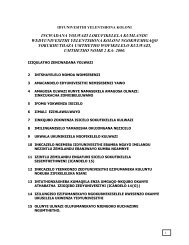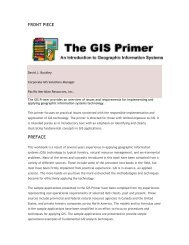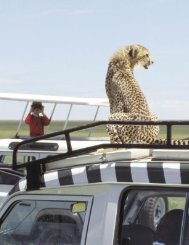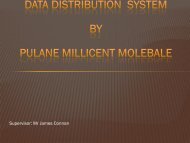Ecosystem Guidelines for Environmental Assessment
Ecosystem Guidelines for Environmental Assessment
Ecosystem Guidelines for Environmental Assessment
You also want an ePaper? Increase the reach of your titles
YUMPU automatically turns print PDFs into web optimized ePapers that Google loves.
MIDLAND & MOUNTAIN<br />
will move in from neighbouring areas; recovery is possible within three fire cycles (20-120 years). For<br />
large areas, rates of recovery are 50 m from the edge per fire cycle (5-40 years) <strong>for</strong> serotinous species<br />
and 10 m per fire cycle <strong>for</strong> myrmecochorous species. If regeneration is insufficient to carry a fire,<br />
recovery will take much longer. Southern Cape areas with more regular rainfall will restore much faster<br />
than drier ones.<br />
If serotinous species are lost from the system (as happens under aliens or too-frequent burning),<br />
recovery takes about three fire cycles if remnant patches survive. Otherwise seeds should be broadcastsown<br />
after the first post-fire rains.<br />
Recovery of myrmecochorous species is slower and more labour-intensive (and costlier) than <strong>for</strong><br />
serotinous species.<br />
What are acceptable trade-offs, compensation or off-sets<br />
<strong>for</strong> biodiversity loss<br />
Habitat in threatened (Critically Endangered and Endangered) ecosystems, corridors and vegetation<br />
boundaries must be avoided, as must sensitive habitats such as wetlands and riparian fringes.<br />
For all types of development, footprints should be minimised. The focus should be on selecting<br />
alternatives that maximise the retention of indigenous habitat, species and ecological processes. This<br />
means, <strong>for</strong> example, seeking less destructive methods of cultivating buchu, using local indigenous<br />
plants species in landscaping and retaining wetland features as natural habitats and corridors.<br />
Many of the rare species are localised, and these populations can often be avoided by good<br />
environmental assessments and planning.<br />
There are no acceptable trade-offs <strong>for</strong> losing the habitat of Critically Endangered and Endangered<br />
species, or the species themselves.<br />
Large developments are not recommended.<br />
Search-and-rescue is important <strong>for</strong> all development, especially when development may result in the<br />
irreversible loss of rare or threatened plant populations. A specialist botanical report must provide<br />
recommendations on rescue techniques and CapeNature should endorse the sites to which these plants<br />
are translocated. Rehabilitation of rare or threatened plants should not be considered as adequate<br />
mitigation <strong>for</strong> loss of pristine habitat. In the case of sites that will be disturbed by development but<br />
later rehabilitated, search-and-rescue should, as a<br />
minimum, concentrate on saving bulbs and succulents. Frequent, high-intensity summer fires and overharvesting<br />
have reduced the Clanwilliam cedar<br />
Bulbs should be marked in spring when they flower or<br />
Widdringtonia cedarbergensis to remote sites in the<br />
are in leaf, but they should only be transplanted once higher-lying parts of the Cederberg.<br />
their leaves have dried off. In all cases topsoil (upper<br />
150 mm) should be removed be<strong>for</strong>e an area is disturbed<br />
and replaced after the operational phase. In the case<br />
of recently burned sites the seedlings of most shrubs<br />
can be rescued by means of retaining soil sods (± 30<br />
cm x 30 cm x 15 cm deep) in trays. Transplantation of<br />
rescued plants must take place in autumn (March-April).<br />
In threatened ecosystems, or where sensitive habitats<br />
or ecological corridors or vegetation boundaries may be<br />
trans<strong>for</strong>med, biodiversity off-sets must be considered<br />
after all standard mitigation has been carried out. The<br />
selected areas should support vegetation of the same<br />
or better quality than that found on the developed site.<br />
PIETER MALAN<br />
COLIN PATERSON-JONES<br />
50 : MIDLAND & MOUNTAIN FYNBOS ECOSYSTEMS



